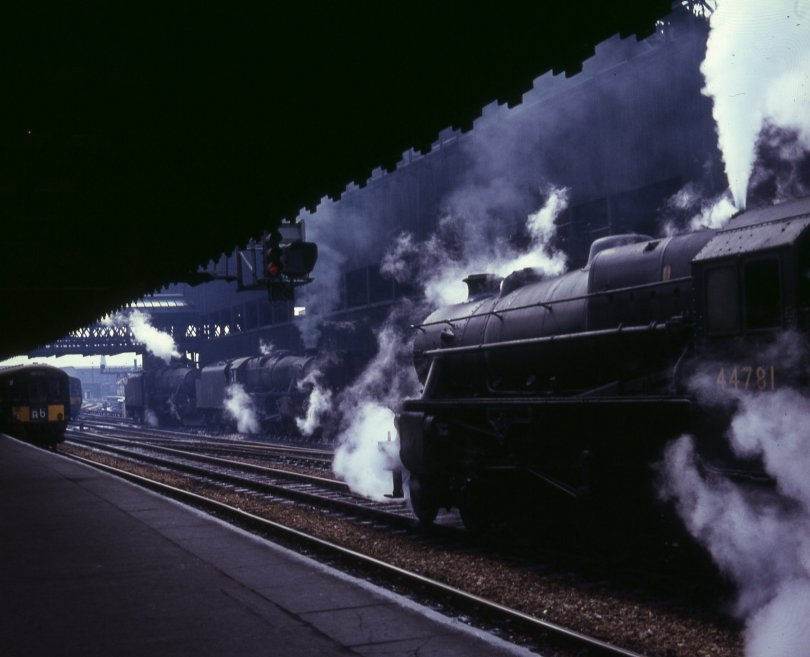
Google has done a stunning job of providing a unique photo montage of the UK street scene, with its photo vans touring the streets of the UK. But what about the railways? Here is a modest attempt to show some of the railway lines of the UK using Google Streetview. The first line mapped is the Liverpool-Southport line in Merseyside. This uses the Lancashire & Yorkshire Railway convention of Up and Down, and makes the journey in the Up direction towards Liverpool.
Each 'view' is in the Up direction, the idea being that the Google navigation tool allows the Down direction to be viewed in the same window. There are some exceptions, where the opposite view is of greater interest.
As it takes a few seconds for each of the Google maps to be retrieved, the line is broken into sections, and generally these are station-to-station.
Manchester - Bolton - Southport Line
Southport Chapel Street - Hawkeshead Street
Hawkeshead Street - Meols Cop
Cobden Road - Wyke Lane
Bescar Lane - Burscough Bridge
Hoscar - Parbold
Parbold Hill - Appley Bridge Station
M6 viaduct - Gathurst - Martland Mill Lane
Scott Lane - Wigan Wallgate
Warrington Road - Ince - Hindley
Westhoughton - Manchester Road bridge
M61 bridge - Lostock Station & Junction
Heaton Bridge - Moor Lane
Bolton West
Bolton Trinity Station - Orlando Street bridge
Lever Street footbridge - Moses Gate
Glenbrook Gardens - Farnworth
Kearsley - Doe Brow bridge
Clifton Junction
Agecroft Road - Salford Crescent
Salford - Manchester Victoria
Manchester Victoria - Normanton
Manchester Victoria - Bromley Street
Rochdale Road - Queens Road, Manchester
Newton Heath - Nuthurst Road bridge
Moston Station - Joshua Lane bridge
Baytree Lane bridge - Castleton South Junction
Castleton North Junction - Boundary Street
Milkstone Road bridge - Rochdale
Oldam Road bridge, Rochdale - Albert Royds Street
Belfield Mill Lane - Fletcher's Road bridge
Smithy Bridge station - Littleborough Station
Littleborough Station - Winterbutlee Tunnel South
Walsden Station - Gauxholme Viaduct
Gauxholme Viaduct - Todmorden Station
Todmorden Viaduct - Millwood Tunnel
Millwood Tunnel - Jumble Hole Road bridge
Stoney Lane bridge - Halifax Road bridge
Stubbin Brink - Hebdon Bridge - Thrush Hill Road
Streamside Fold - Wheatley Royd
Luddendenfoot - Sowerby Bridge Station Road
Sowerby Bridge station - Stainland Road, Greetland
Greetland - Lillands Way, Brighouse
Bridge End, Brighouse - Woodhouse Lane
M62 bridge Brighouse - Heaton Lodge
Calder View - Mirfield
Mirfield Station - Steanard Lane
Sands Lane, Mirfield - Station Road, Dewsbury
Headfield Road bridge, Dewsbury - Healey Mills approaches
Healey Mills yard - Southfield Lane
Dudfleet Lane Horbury - Forge Lane Horbury
Horbury Junction
Denby Dale Road bridge - Wakefield Station
Goose Hill Junction - Normanton Station
Liverpool-Southport Line
Southport Chapel Street - Eastbank Street Bridge
Eastbank Street Bridge - Birkdale
Birkdale - Grosvenor Road
Grosvenor Road - Hillside
Hillside - Ainsdale
Ainsdale - Coast Road
Coast Road - Freshfield
Formby - Hightown
Hall Road - Blundellsands & Crosby
Blundellsands & Crosby - Waterloo
Seaforth & Litherland - North Mersey Branch
Marsh Lane - Bootle New Strand
Bootle New Strand - Bootle Junction
Bootle Oriel Road - Bank Hall
Sandhills - Liverpool Exchange

Photograph Desmond Summers, copyright J K Wallace, all rights reserved
Manchester Victoria with 44818, 44884 & 44781 on 10 May 1968. This was the magic of Victoria, right at the heart of the old Lancashire & Yorkshire Railway system. As a young boy I cherish the memories and am grateful for having lived in the north west at the end of steam. Modernisation is represented by a Metro-Cammell Class 101 dmu on the the through road, whilst a Class 104 sits at the platform which connected with the LNWR's Exchange Station next door, and so formed the longest platform in the country. It is only relatively recently that it occurred to me that this might be turned round. Rather than British Railways favouring the old Lanky system with the end of steam, in actual fact it was the last division of the national system to be modernised. Two thirds of the last active locomotive sheds were Lanky, namely Lostock Hall and Rose Grove. The other shed was the L&NWR's Carnforth.
By the time this photograph was taken, the only Lanky sheds still open were Lostock Hall and Rose Grove, along with Bolton and Newton Heath. These last two were to close on 30 June 1968 and 1 July 1968 respectively. There had been a reprieve from further closures after Low Moor closed on 2 October 1967. Wakefield and Aintree had closed on 3 and 12 June 1967 respectively.
